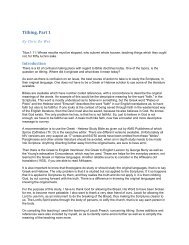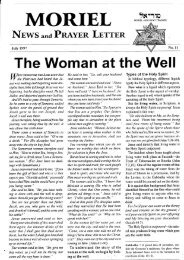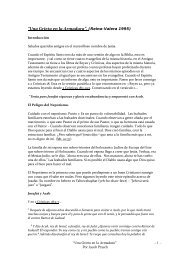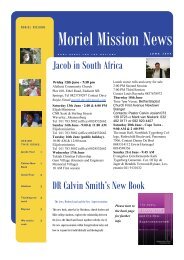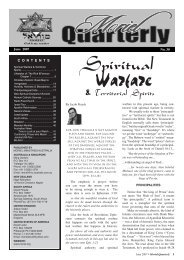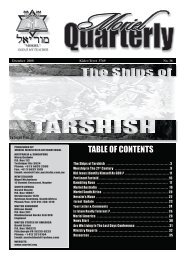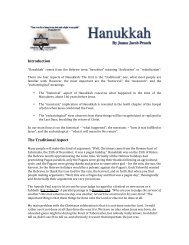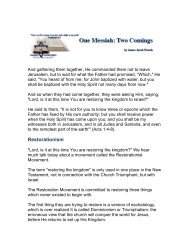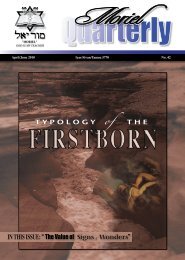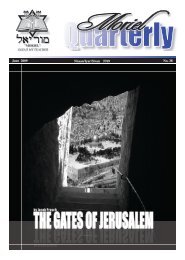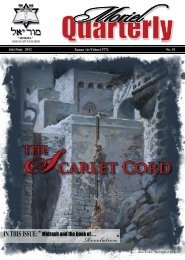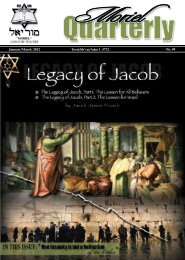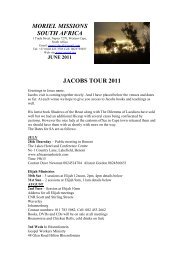Types of Rapture (~9.1 MB) - Moriel Ministries
Types of Rapture (~9.1 MB) - Moriel Ministries
Types of Rapture (~9.1 MB) - Moriel Ministries
You also want an ePaper? Increase the reach of your titles
YUMPU automatically turns print PDFs into web optimized ePapers that Google loves.
Feature Article – Continued<br />
Elijah and John the Baptist. Notice<br />
how this connects the resurrection with<br />
the transfiguration. Jesus commanded<br />
His disciples not to tell anyone about<br />
the transfiguration until His resurrection.<br />
Why Elijah and Moses are the two<br />
prophets <strong>of</strong> Israel most associated with the<br />
Messiah in the New Testament and also<br />
in Jewish thought. Moses was a man who<br />
died faithful to God. Jesus was God who<br />
became a man. Elijah was someone who<br />
never died but was raptured, or caught up<br />
to Heaven alive.<br />
So there stood the Lord Jesus with<br />
someone who was raptured and never died,<br />
and someone who died. They all looked<br />
exactly the same. They were all transfigured.<br />
We shall be as He is. It doesn’t<br />
matter if we are raptured or if we die<br />
faithful to God, we shall meet Him in<br />
the air. This was on Mount Hermon, a<br />
white-covered mountain most <strong>of</strong> the year.<br />
Where do we meet Him In the sky, above<br />
the gods <strong>of</strong> this world. Do you understand<br />
the typology Now there is more. When we<br />
read the Apocrypha, we get the background<br />
to what the Epistle <strong>of</strong> Jude tells us in the<br />
NEW TESTAMENT about the nephilim, or<br />
rapha, the giant <strong>of</strong>fspring <strong>of</strong> fallen angels<br />
joined with women. These fallen angels<br />
were “demonoids” who came down and<br />
procreated with human women. It is said<br />
that they came down at this very mountain.<br />
So you have the conflict between Jesus<br />
and the political powers <strong>of</strong> the world, the<br />
Hellenistic religions <strong>of</strong> the world which<br />
are demonic. It all happens in the same<br />
geographical location.<br />
In midrash (the Jewish way <strong>of</strong><br />
interpreting Scripture), where things<br />
happen in the same geographical location<br />
it is an indication that there is a theological<br />
and a spiritual relationship between those<br />
events, even though there might not appear<br />
to be. For instance, Elisha, Elijah, and<br />
John the Baptist all had the same spirit,<br />
or anointing. Where did Elisha take the<br />
mantle <strong>of</strong> authority from Elijah On the<br />
plain <strong>of</strong> Jericho, the same place where John<br />
the Baptist was baptizing. And they had the<br />
same spirit. You will frequently find this<br />
same confluence <strong>of</strong> events in Scripture.<br />
We have to look at what else happened<br />
in a given location to understand the full<br />
dimension <strong>of</strong> its spiritual and theological<br />
significance. One who died in Christ or, as<br />
it were, was faithful to God under the Law<br />
<strong>of</strong> Moses, somebody who was raptured,<br />
and the Lord Himself, all looked the same.<br />
Moses wanted to enter the Promised Land<br />
but he was unable to for a variety <strong>of</strong> reasons.<br />
One reason is because Moses represented<br />
the Law. It was Joshua who could bring<br />
the people into the Promised Land. Jesus’<br />
name in Hebrew, YESHUA, is simply the<br />
way they said Joshua (Y’HOSHUAH)<br />
after the captivity. Joshua becomes a<br />
picture <strong>of</strong> Jesus while Moses in this sense<br />
becomes the picture <strong>of</strong> the Law. The Law<br />
cannot lead us into Heaven; only Jesus can.<br />
Hence Moses could not enter the Promised<br />
Land. But once the Messiah comes again,<br />
he will. God told Moses he couldn’t go in,<br />
but then God does eventually answer Moses’<br />
prayer. He will walk in the land, but<br />
only when the Messiah comes.<br />
Now, that is a pretty good basis but let<br />
us begin considering further. Let’s look at<br />
some <strong>of</strong> the people who were raptured and<br />
some who were resurrected. Let us look at<br />
the Book <strong>of</strong> Genesis:<br />
When Adam had lived one hundred<br />
and thirty years, he became the father<br />
<strong>of</strong> a son in his own likeness, according<br />
to his image, and named him Seth.<br />
(Genesis 5:3NAS)<br />
Man is made in God’s image and<br />
likeness. God is creative and He makes<br />
us procreative so that our <strong>of</strong>fspring<br />
come in our own image and likeness.<br />
We read further:<br />
And Enoch lived sixty-five years,<br />
and became the father <strong>of</strong> Methuselah.<br />
Then Enoch walked with God<br />
three hundred years after he became<br />
the father <strong>of</strong> Methuselah, and he had<br />
{other} sons and daughters.<br />
So all the days <strong>of</strong> Enoch were three<br />
hundred and sixty-five years.<br />
And Enoch walked with God; and<br />
he was not, for God took him.<br />
And Methuselah lived one hundred<br />
and eighty-seven years, and became<br />
the father <strong>of</strong> Lamech.<br />
Then Methuselah lived seven<br />
hundred and eighty-two years after he<br />
became the father <strong>of</strong> Lamech, and he<br />
had {other} sons and daughters.<br />
So all the days <strong>of</strong> Methuselah were<br />
nine hundred and sixty-nine years, and<br />
he died. (Gen 5:21-27NAS)<br />
The first person to be raptured was<br />
Enoch. Every rapture and every resurrection<br />
teaches something about ours. Let’s look at<br />
2 Kings 2:11-12:<br />
Then it came about as they were<br />
going along and talking, that behold,<br />
{there appeared} a chariot <strong>of</strong> fire and<br />
horses <strong>of</strong> fire which separated the<br />
two <strong>of</strong> them. And Elijah went up by a<br />
whirlwind to heaven.<br />
And Elisha saw {it} and cried out,<br />
“My father, my father, the chariots <strong>of</strong><br />
Israel and its horsemen!” And he saw<br />
him no more. Then he took hold <strong>of</strong><br />
his own clothes and tore them in two<br />
pieces. (NAS)<br />
Elijah was raptured. Some people<br />
believe that it is Elijah and Enoch who<br />
will come back as the two witnesses <strong>of</strong><br />
Revelation 11:3. Others believe that it<br />
is Moses and Elijah because they were<br />
the ones transfigured. Let’s look at 2<br />
Corinthians 12:1-4:<br />
Boasting is necessary, though it<br />
is not pr<strong>of</strong>itable; but I will go on to<br />
visions and revelations <strong>of</strong> the Lord.<br />
I know a man in Christ who<br />
fourteen years ago – whether in the<br />
body I do not know, or out <strong>of</strong> the body I<br />
do not know, God knows – such a man<br />
was caught up to the third heaven.<br />
And I know how such a<br />
man – whether in the body or apart<br />
from the body I do not know, God<br />
knows – was caught up into Paradise,<br />
and heard inexpressible words, which a<br />
man is not permitted to speak. (NAS)<br />
If you were to translate “caught up” in<br />
verse 1 from the Latin Vulgate you would<br />
have the same Latin word from where we<br />
get “rapture.”<br />
The context <strong>of</strong> these verses pretty<br />
well tells us it is Paul himself who had<br />
this rapture experience. He was caught up<br />
and he then was sent back. If it is literally<br />
to be Elijah who comes back as one <strong>of</strong><br />
the two witnesses that would be the Old<br />
Testament precedent. But <strong>of</strong> course it<br />
begins with Jesus. He came down from<br />
Heaven. He is always prolific. He is sent<br />
and He comes back again. What happens<br />
to Jesus begins to happen to His disciples.<br />
It’s prolific. He is the first <strong>of</strong> a kind. Our<br />
experience <strong>of</strong> ascending and coming back<br />
teaches something about His.<br />
Let me go back to our first text.<br />
Peter wanted to build three booths.<br />
Why did he want to build three booths,<br />
three tabernacles The Feast <strong>of</strong> Tabernacles<br />
was the last Jewish feast <strong>of</strong> the year. Jews<br />
commemorate God’s provision for their<br />
ancestors in the wilderness during their<br />
exodus, but it is also the thanksgiving for<br />
the autumn harvest. We see it in a millennial<br />
context in Ezek. 47. In John Chapter 7 it is<br />
being celebrated when Jesus talks about<br />
living water. They would take water from<br />
the pool <strong>of</strong> Shiloach and pour it out on the<br />
Temple Mount.<br />
Why these booths and why do the Jews<br />
associate it with the Millennium Look at<br />
Zechariah 12: 10:<br />
And I will pour out on the house<br />
<strong>of</strong> David and on the inhabitants <strong>of</strong><br />
Jerusalem, the Spirit <strong>of</strong> grace and<br />
supplication, so that they will look on<br />
Me whom they have pierced; and they<br />
June 2008 • <strong>Moriel</strong> Quarterly




